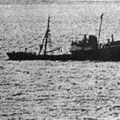Wrecks of Scapa Flow
The astonishing diversity of wrecks, along with the fascinating stories behind them, make Scapa Flow a world-renowned location for all those interested in maritime history.
Orkney has a unique underwater environment, from vast battleships resting in the heart of Scapa Flow, to smaller blockships dotted along the rugged coastline.
There is a real poignancy to seeing the wrecks on the seafloor of the Flow, an area that is teeming with a history that spans the centuries and encompasses both grievous losses and magnificent victories.
HMS Royal Oak and HMS Vanguard are war graves which must not be disturbed but technical divers and sport divers alike can visit many of the other wrecks scattered throughout Orkney's waters. These include the seven remaining warships of the German High Seas Fleet.
Each wreck provides an emotive insight into a bygone era, compelling divers to return to Orkney time and time again.
For non-divers, these pages give the opportunity to experience the wrecks from afar – and without the need to don a drysuit.
German High Seas Fleet
In late November 1918 the German High Seas Fleet arrived in Scapa Flow for internment. On 21 June 1919, believing the British intended to seize the fleet, Rear Admiral Ludwig von Reuter gave the order to scuttle every ship.
Today the wrecks of three battleships, three light cruisers and a fast mine-layer – ships that all escaped complete removal during salvage operations – remain on the seabed of Scapa Flow.
Lying between 45 and 12 metres under the surface, these wrecks have become imposing and insightful pieces of history. They offer distinct and rare diving experiences.
War Graves
HMS Royal Oak and HMS Vanguard were British battleships that sank in Orkney waters, the former in World War II due to enemy action, the latter in World War I due to an accidental explosion. In total more than 1,600 men were killed.
Today both wrecks are afforded statutory protection as designated war graves under the Protection of Military Remains Act 1986. The Act makes it a criminal offence to remove or tamper with any item that is part of a wreck designated under the Act without a government licence. There are currently 67 such wrecks designated in UK or international waters.
Wrecks Protected Status
In recognition of their historical and cultural importance, the wrecks of the Cöln, Dresden, Brummer, Karlsruhe, Kronprinz Wilhelm, König and Markgraf have been protected as scheduled monuments. Divers are welcome to enjoy and respect these wrecks but removal of artefacts from them is illegal. For more information, please visit the: MCA Website


































